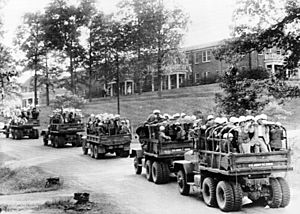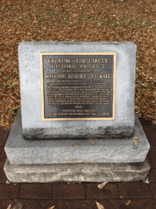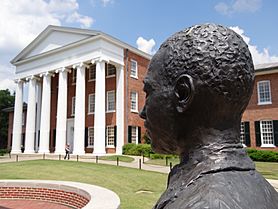Ole Miss riot of 1962 facts for kids
Quick facts for kids Ole Miss riot of 1962 |
|||
|---|---|---|---|
| Part of the Civil Rights Movement | |||
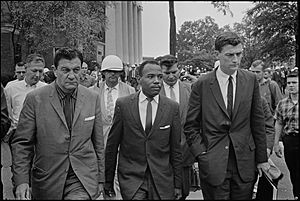
Chief U.S. Marshal James McShane (left) and Assistant Attorney General for Civil Rights, John Doar (right) of the Justice Department, escorting James Meredith to class at Ole Miss.
|
|||
| Date | September 30, 1962 – October 1, 1962 (2 days) | ||
| Location | |||
| Caused by |
|
||
| Resulted in |
|
||
| Parties to the civil conflict | |||
|
|||
| Casualties | |||
| Death(s) | 2 | ||
| Injuries | 300 | ||
The Ole Miss riot of 1962, or Battle of Oxford, was an incident of mob violence by proponents of racial segregation beginning the night of September 30, 1962. Segregationist opposition to the enrollment of James Meredith, an African-American veteran, at the University of Mississippi (also known as Ole Miss), in Oxford, Mississippi became violent.
In the wake of the Supreme Court's 1954 decision Brown v. Board of Education, Meredith tried to integrate Ole Miss by applying in 1961. When he informed the university that he was African American, his admission was delayed and obstructed, first by school officials and then by Mississippi Governor Ross Barnett. In a bid to block his enrollment, Barnett even had Meredith temporarily jailed. Multiple attempts by Meredith, accompanied by federal officials, to enroll were physically blocked. Hoping to avoid violence and ensure Meredith's enrollment, President John F. Kennedy and Attorney General Robert F. Kennedy had a series of unproductive telephone conversations with Barnett.
Federal and U.S. state law enforcement were dispatched to accompany Meredith during his registration to maintain civil order, but a riot erupted on campus. Partly incited by General Edwin Walker, the mob assaulted reporters and federal officers, burned and looted property, and hijacked vehicles. Two civilians, including a French journalist, were murdered during the night, and over 300 were injured, including one-third of the federal law enforcement personnel deployed. The riot ended when over 13,000 soldiers arrived in the early morning. Over 30,000 troops were deployed, alerted, and committed during the conflict−the largest for a single disturbance in American history.
The riot was followed by the desegregation of Ole Miss. A statue of James Meredith now commemorates the event on campus, and the site of the riot is designated as a National Historic Landmark.
Contents
Leadup
Meredith's attempts to enroll
In 1954, the U.S. Supreme Court ruled in Brown v. Board of Education that segregation in public schools was unconstitutional. Eight years after the Brown decision, every Mississippi school district remained segregated, and all attempts by African American applicants to integrate the University of Mississippi—better known as Ole Miss—had failed. Shortly after the 1961 inauguration of President John F. Kennedy (who promised advances in civil rights), James Meredith applied to Ole Miss. Meredith, an African American who had served in the Air Force and completed coursework at Jackson State University, selected Ole Miss as it was a symbol of "white prestige and power" attended by the children of the state's elite. Meredith did not inform the university of his race until midway through the application process. State officials then obstructed and delayed his application, ultimately for 20 months.
In response, Meredith sued the university in late 1961. After months of obstruction by the Fifth Circuit Court of Appeals' Benjamin Franklin Cameron, Meredith appealed to the U.S. Supreme Court. On September 10, 1962, Justice Hugo Black delivered the court's decision: Meredith must be admitted for the fall semester. Mississippi's segregationist Governor Ross Barnett, himself a graduate of Ole Miss, had the Mississippi Legislature pass a law barring the university enrollment of anyone with a charge of "moral turpitude" in state or federal court. Barnett then had Meredith charged and imprisoned for accidentally writing "1960" instead of "1961" while registering to vote; the Fifth Circuit quickly ordered Meredith's release.
Under Attorney General Robert F. Kennedy's orders, the Department of Justice (DOJ) entered the case on Meredith's behalf. Facing contempt charges and jail, the university's board transferred its powers, and liability, to Governor Barnett. Meredith then travelled to the Ole Miss campus in Oxford, Mississippi to register; he was blocked by Barnett, who read and presented a proclamation. In a second attempt, Meredith, accompanied by DOJ civil-rights division chief John Doar and chief U.S. marshal James McShane, tried to register at the Woolfolk State Office Building in Jackson. He was again physically blocked by Barnett, who issued the rehearsed quip: "Which one is Meredith?" Another attempt to register at Ole Miss was stopped by lieutenant governor Paul B. Johnson Jr. and lines of state troopers.
Kennedy dialogue and escalating tensions
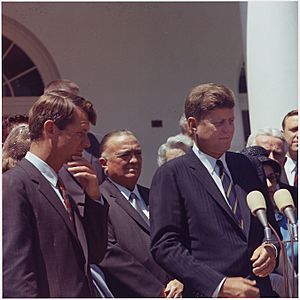
The Kennedy brothers hoped to resolve the dispute peacefully and avoid federal troop deployment, as had happened in the Little Rock Crisis (1957). Their overwhelming concern was that a "mini-civil war" between the federal troops and armed protesters might erupt. Following the precedent he had established with his discussions with Alabama Governor John Patterson during the Freedom Rides, Robert Kennedy had extensive telephone conversations with Barnett to resolve the issue.
On September 27, the governor offered to enroll Meredith if federal marshals drew their guns on Barnett's head, saving his reputation among the voters of Mississippi. Kennedy rejected the suggestion. In addition to Meredith's enrollment, Kennedy insisted Barnett pledge that he would maintain law and order. Barnett believed that the White House's public threats of federal forces were little more than bluffs. President Kennedy had extensive discussions with his staff and with Governor Barnett about protecting Meredith. Although Barnett alternated between bluster and placation while on the phone with the Kennedys, to the public he vowed to keep the university segregated.
On September 28, the Fifth Circuit found Barnett to be in contempt of court and threatened to imprison Barnett and fine him $10,000 daily if Meredith were not registered by October 2. During half time at a September 29 Ole Miss football game, Barnett issued a defiant speech: "I love Mississippi! I love her people! Our customs! I love and respect our heritage!" President Kennedy federalized the Mississippi National Guard shortly after. The following day, rumors spread that Kennedy's federal agents were preparing to arrest Barnett at the Governor's Mansion in Jackson. White-supremacist Citizens' Councils organized a "wall of human flesh"—over 2,000 people—to surround the mansion and protect Barnett, but the alleged federal arrest never materialized. Anticipating violence at Ole Miss, 182 journalists flocked to Oxford to witness Meredith's next enrollment attempt. Photographers saw the visual potential of Meredith's plight: "a solitary man against thousands".
Events
Start of the riot
In accordance with Barnett and Kennedy's plan, on Sunday evening, September 30, the day before the anticipated showdown, Meredith was flown to Oxford. Shortly before 7 p.m., he was escorted by 24 federal marshals to his guarded dormitory. The federal agents assembled on campus, supported by the 70th Army Engineer Combat Battalion from Fort Campbell, Kentucky. They converted the university's administration building, the Lyceum, into their operations headquarters. Local police established barriers to prevent the entry of all except for students and faculty.
Beginning in the late afternoon, Ole Miss students gathered in front of the Lyceum. As the evening progressed, more outsiders arrived on campus and the crowd became rowdier. Former Major General Edwin Walker appeared on campus to encourage the mob. Earlier, Walker had made a radio appeal for 10,000 volunteers to "rally to the cause of freedom" at Ole Miss. Within an hour of Meredith's arrival, the riot had begun.
As the scene grew more out of control, the highway patrol initially helped hold off the crowds but, despite Barnett's renewed commitment, police were withdrawn by State Senator George Yarbrough starting at about 7:25 p.m. As they abandoned the federal officers, the local and state police dismantled all barriers, allowing large numbers of agitators from other states to enter the campus. The Kennedys instructed the marshals not to fire under any circumstances—even if overwhelmed by the mob—except if Meredith's life was in imminent danger.
Violence on campus

As the mob reached a size of 2,500, they became increasingly violent, assaulting reporters and throwing Molotov cocktails and bottles of acid at the marshals. Reporters and wounded marshals, including one shot in the throat, sheltered in the Lyceum. At 7:50 p.m., chief marshal James McShane ordered his federal officers to fire tear gas at the mob. Attempts by an Ole Miss football player and an Episcopalian rector to reason with the mob and stem the violence failed. At one point, however, Ole Miss students prevented others from removing the American flag and raising the Confederate flag.
At 11 p.m., Governor Barnett issued a radio address; many believed that he would try to deescalate the violence. However, Barnett only further encouraged the riot, declaring, "We will never surrender!"
Rioters twice attempted to drive a bulldozer into the marshals, and others commandeered a fire engine. All streetlights were shot or smashed with rocks, limiting visibility. Five cars and a mobile television unit were burned. Laboratories were raided and looted by rioters hoping to find more materials for Molotov cocktails and acid bottles.
Under the cover of darkness, rioters shot at marshals and reporters; the marshals never returned fire. Several men were wounded. Marshal Graham Same of Indianapolis nearly died after a bullet hit his neck. An Associated Press reporter was shot in the back with pellets but refused medical attention, continuing to file reports via telephone. At 1 a.m., reporter Karl Fleming was narrowly missed by a sniper; three shots hit the Lyceum wall around his head. A car was flipped with a reporter still inside.
Barnett agreed to a request from President Kennedy to ask the state officers to return to the campus; Barnett never did.
The crowd swelled to about 3,000. As its behavior turned increasingly violent, the federal agents ran out of tear gas defending the officials in the Lyceum. President Kennedy reluctantly invoked the Insurrection Act of 1807 and called in reinforcements in the middle of the night under the command of Brigadier General Charles Billingslea, Commanding general of the United States Army's 2nd Infantry Division. He ordered in U.S. Army military police from the 503rd, 716th, and 720th Military Police Battalions—which had previously been readied for deployment under cover of the nuclear war Exercise Spade Fork—the 2nd Battle Group, 2nd Infantry Division, the 31st Helicopter Company, and the federalized Mississippi National Guard. United States Navy medical personnel (physicians and hospital corpsmen) attached to the U.S. Naval Hospital in Millington, Tennessee as well as 101st Airborne Division communications and medical personnel were also sent to the university.
Before military support arrived, white rioters roaming the campus discovered Meredith was in Baxter Hall and started to assault it, with possible intent to lynch Meredith. Early in the morning, as Gen. Billingslea's party entered the university gate, a white mob attacked his staff car and set it on fire. Billingslea, the Deputy Commanding General John Corley, and aide, Capt Harold Lyon, were trapped inside the burning car, but they forced the door open, then crawled 200 yards under gunfire from the mob to the University Lyceum Building. The Army did not return this fire.
According to Robert Kennedy, Secretary of the Army Cyrus Vance provided the president with poor and misleading advice.
At 1 a.m., 200 military police officers arrived on the campus. The secretary of the Army repeatedly promised President Kennedy to have his men at the campus in two hours, but instead they did not roll into the campus until five hours later; a total of 25,000 soldiers. They evacuated the wounded from the Lyceum and began arresting rioters. Of the 300 arrested, only a third were students from Ole Miss. Walker was among those arrested. He was charged with insurrection. By the end of the 15-hour riot, one third of the federal agents, a total of 166 men, were injured in the melee, and 40 federal soldiers and Mississippi National Guardsmen were wounded.
Aftermath
Two civilians were murdered during the riots: French journalist Paul Guihard, on assignment for Agence France-Presse (AFP), who was found behind the Lyceum building with a gunshot wound to the back; and 23-year-old Ray Gunter, a white jukebox repairman who had visited the campus out of curiosity. Gunter was found with a bullet wound in his forehead. Law enforcement officials described these as execution-style killings. According to historian William Doyle, "It was a sheer miracle that scores, if not hundreds, of Americans were not slaughtered that night."
The day after the riot, Barnett called the DOJ and offered to pay for Meredith's college education anywhere out-of-state. Barnett's final plea was rejected. On October 1, 1962, Meredith became the first African-American student to be enrolled at the University of Mississippi, and attended his first class, in American History. His admission marked the first integration of a public educational facility in Mississippi. Following rumors of dynamite in Baxter Hall, an October 31 search by troops and campus police discovered a grenade, gasoline, and a .22-calibre rifle, among other weapons. At that time, there were still hundreds of troops guarding Meredith 24 hours a day. In order to appease the local sensitivities, however, 4,000 Black soldiers were removed from the Federal troops under Robert Kennedy's secret orders.
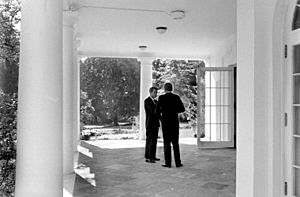
The strength of all forces deployed, alerted, and committed in Oxford was around 30,656 — the largest for a single disturbance in American history.
Although press coverage of the Kennedys' handling of the riot was largely positive and glossed over their poor planning and execution, their handling of the crisis angered both white and black Southerners. According to Louis F. Oberdorfer, Robert Kennedy underestimated the "extent to which segregation in the South was undergirded by violence." Kennedy reportedly blamed himself for failing to prevent the riot.
After a request by the university, Chairman of the Senate Judiciary Committee James Eastland began preparing a subcommittee led by Senator Sam Ervin (North Carolina) to investigate the riot. Barnett had Eastland quash the subcommittee. Instead, the Mississippi Legislature and a Lafayette County grand jury conducted investigations, and blamed the marshals and DOJ for the violence.
Legacy
The event is regarded as a pivotal moment in the history of civil rights in the United States. According to Larry Tye, this event is remembered as one where the federal government stood up "not just for the rule of law, and against mob violence, but for racial justice."
Charles W. Eagles described Meredith's achievement by the following: In a major victory against white supremacy, he had inflicted a devastating blow to white massive resistance to the civil rights movement and had goaded the national government into using its overpowering force in support of the black freedom struggle.
Because of the civil rights significance of Meredith's admission, the Lyceum-The Circle Historic District where the riot took place has been designated as a National Historic Landmark and state historic district. A statue of James Meredith has been erected on the campus to commemorate his historic role. The university conducted a series of programs for a year beginning in 2002 to mark the 40th anniversary of its integration. In 2012, it initiated a yearlong series of programs to mark its 50th anniversary of integration. Meredith's son attended the university.
Several singers made songs about this event:
- Bob Dylan wrote and sang about the events in his song "Oxford Town"
- Phil Ochs wrote "The Ballad of Oxford"
- Gene Greenblath wrote "Talking Ole Miss"
- The Chad Mitchell Trio recorded the song "Alma Mater"
See also
 In Spanish: Disturbios en la Universidad de Misisipi de 1962 para niños
In Spanish: Disturbios en la Universidad de Misisipi de 1962 para niños



